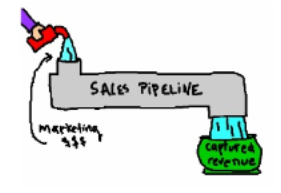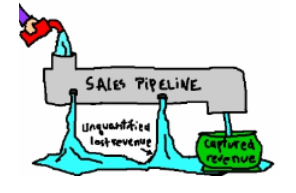For many businesses, a pipeline report can just be a summary of the sales team’s hopeful goals. After all, being optimistic is a key trait of salespeople. When these hopeful predictions result in disappointment or financial trouble for the company, the sales team often gets blamed. That isn’t fair.
Within your CRM (Customer Relationship Manager) you can set up a process of measurements that will stop, or at least reduce, the leakage. You will gain accountability of sales forecasts, an ability to tweak the sales process and sales lead retention through nurturing email campaigns.
Accurate Pipeline Reports
 Way beyond the aspect of sales, an accurate pipeline report is critical to business success. When projections are too low, your company can end up under resourced. Because you are not prepared for the sales, you may be unable to capitalize on the opportunities that show up.
Way beyond the aspect of sales, an accurate pipeline report is critical to business success. When projections are too low, your company can end up under resourced. Because you are not prepared for the sales, you may be unable to capitalize on the opportunities that show up.
Projections that are too high can also be damaging when you allocate too much resource based on an overly rosy forecast. Higher inventory, staffing and other expenses may cause the company to be upside down when profits are not made.
In a recent eBook, “Manage a Sales Process of Actions that Lead to Sales”, we broke down the steps to make improved pipeline reporting easier to understand. We even covered the benefits of an accurate pipeline report when you talk to bankers about a business loan.
Sales Process Measurement

Assessing each key step in the process will offer you a new viewpoint. Eventually, you’ll reach a stage where you can state… last month we made X cold calls that led to Y sales. Using the data from the previous month, you can predict future sales based on every stage in the process.
The information is empowering to the sales team because they don’t have to stress about which customer is going to buy. They just need to show up every day and follow the steps of the process.
The accumulated data becomes even more powerful over time. You will begin to find areas where the process gets stuck. You may find that you make cold calls, set appointments, do a lot of presentations and proposals. But things just don’t move past that. This is very powerful information that will allow you to adjust and improve the process. It is information that would be missed by the traditional sales forecast you would make without a good CRM.
Lead Nurturing
It is tragic to spend lots of money creating a flood of sales leads and then see them wasted. Don’t blame the sales team. Make a change in the sales process.
Using email automation, you can set up a sales lead nurturing program. Decision makers tend to take more time to purchase these days. They feel responsible for knowing everything about the product or service before taking any action. Meet them where they are comfortable and deliver an email campaign that informs, entertains and establishes trust.
Getting the right people into a lead nurturing email campaign begins with a good qualifying process. Your sales team needs to be able to quickly determine if a prospect is qualified for spending time on an appointment. They need to know how and why to say “No” to unqualified prospects and focus on the ones who are most likely to purchase in the near term. Developing skill in qualifying sales leads is critical to closing more business with fewer resources.
No company can afford to let all the hard work of generating sales leads to leak out of the pipeline. These three proven tactics can help you stop the spillage.